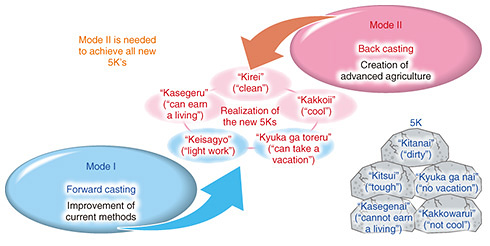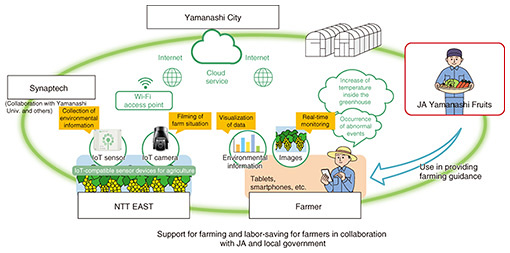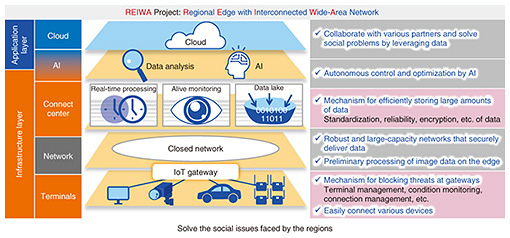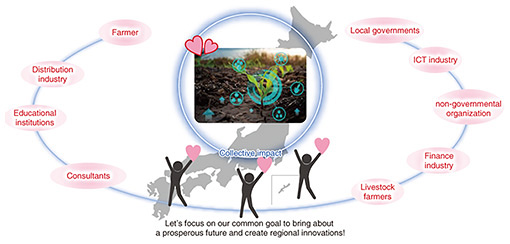 |
|
|
|
|
|
Feature Articles: Keynote Speeches/Workshop Lectures at Tsukuba Forum 2019 Vol. 18, No. 4, pp. 35–42, Apr. 2020. https://doi.org/10.53829/ntr202004fa6  Pioneering a Prosperous Future with Regional InnovationsAbstractThis article introduces the NTT EAST Group’s latest efforts in agriculture to make Japan more prosperous through the revitalization of small and medium-sized enterprises and primary industries in Japan’s regions. It also introduces the importance of collective impact in creating new value with a variety of stakeholders and a concept for creating an open social platform. This article is an edited version of the keynote speech given by NTT EAST Senior Executive Vice President Naoki Shibutani at Tsukuba Forum 2019, held on October 31 and November 1, 2019. Keywords: regional innovation, open social platform, data-driven society 1. Do innovations occur in Japan?Japan is ranked sixth in the World Economic Forum’s global competitiveness ranking. However, from indicators of the country’s suitability for innovative business, Japan is ranked 14th, a low standing among developed countries. The world’s gross domestic product (GDP) has grown over the last 30 years. As part of this trend, Japan’s GDP has grown 120%. However, the GDP of European Union countries have at least doubled, while the GDP of the United States has grown 330% and China’s has grown more than tenfold. Considered in this light, Japan has become a country that really does not grow. Can the people of a country without economic growth be happy? Japan is ranked 58th in the World Happiness Report. This suggests that the Japanese, faced with social issues such as a low birthrate, aging society and pension crisis, have a hard time feeling happiness that comes from having children with peace of mind and leaving a legacy to the next generation. Many of the top spots in the happiness ranking are occupied by small countries such as those in northern Europe. However, these countries also enjoy growing per-capita GDP. Japan, on the other hand, does not have a view that tomorrow will be better than today or a future 20 years down the road will be better than tomorrow. 2. Have innovations by GAFA (Google, Amazon, Facebook, and Apple) brought happiness?What innovations should occur in Japan? Revenues of GAFA, which have created innovations that dominate the world, have certainly been increasing sharply. However, there is a book, titled Hired: Six Months Undercover in Low-Wage Britain about the experience of working in an Amazon.com warehouse and as an Uber driver. I went to Seattle earlier this year and observed an Amazon warehouse. I saw how artificial intelligence (AI) efficiently controlled workers and systems. Amazon workers have heavy workloads at low wages, for which Amazon is being criticized by the mass media. Labor’s share of the economy in the United States has been trending downward. The theory is that large companies, such as GAFA, have kept profits to themselves instead of returning them to their workers. 3. Open social platformGAFA adopt a business model based on the monopolization of collected data. In this model, world data are sucked up using a variety of methods such as social networking services and advertising models, and the data are used to improve the company’s products and content. Many people worldwide are now raising their voices in concern over this business model. At NTT, our business model does not monopolize data. Instead, we create data lakes that gather data from all sorts of places and willingly share them with the rest of society. Together with all of you, we want to create a society that can become more prosperous. If we create a model with which data are used by all of society, then Japan will once again draw the attention of the rest of the world. 4. Leverage AI so that people can do more creative workHow to promote a set of ethics of AI and people co-existing, instead of people being used by AI, is being debated (Fig. 1). If we can create AI that plays a supporting role in helping people when they are in trouble instead of AI being used in place of people, then I believe we can achieve social innovations that command the attention of the world.
4.1 Japan’s renaissance will be difficult without regional revitalizationI will now explain NTT EAST’s efforts to reinvigorate Japan based on our partnerships with our customers. Japan’s working population is continuing to decline; therefore, we must consider how to move Japan forward. Japan’s per-capita productivity is ranked 20th among Organization for Economic Cooperation and Development (OECD) countries, an extremely low position. However, if we look at just the productivity of Tokyo, we see that its productivity exceeds that of sixth-ranked United States. This fact shows that without thinking about how to revitalize Japan’s regions, it will be difficult for Japan to grow again. 4.2 Innovation by improving the productivity of small and medium-sized enterprises (SMEs)Another challenge is the disparity between SMEs and large companies. The productivity of large companies is high. In the past ten-odd years, however, the productivity of SMEs has not grown. SMEs make up 99.7% of all companies in Japan. We must think about how to create digital transformations in SMEs and improve their productivity. More than half of all owners of Japanese SMEs are over the age of 70. Increasingly, they are shuttering their companies, not because of stalled business leading to bankruptcy but because there are no successors to take over the businesses, despite them still being profitable. Another challenge facing regional SMEs is that they have no information technology specialists who can use technologies to reduce workload and improve productivity. If AI can handle the heavy labor of a job, many farmers and manufacturers may be able to continue their business. However, it is currently difficult to extend a helping hand to these SMEs. 5. Creating regional employment by revitalizing primary industriesI would like to reiterate the general social trend taking place throughout Japan. Japan’s population is falling, and in 2065, there needs to be 1.3 persons of working age to support one elderly individual. We must work to grow Japan and create a path to double its per-capita income. Looking at the number of workers in each sector of the economy (Fig. 2), we see that young people are heavily employed in the service sector, whose customers are mainly based in Japan. The primary industry sector, i.e., industries concerned with providing the raw materials for manufacturing such as agriculture, fishery, and forestry, is shrinking yearly. While Japan’s regions depend heavily on such industries, the country has not focused on how to strengthen them, particularly regarding agricultural production, livestock husbandry, and fisheries. How to reinvigorate these industries will be the key to regional revitalization.
Over the past 50 years, the number of agricultural workers has fallen 80%. What’s more, 80% of these workers are over the age of 60, and abandoned farmlands are increasing rapidly. If we can effectively use land and improve productivity, then not only the manufacturing industry but also primary industries can become export industries and serve as another pillar of Japan’s economy. We therefore seek to revitalize Japan’s regions through improving SMEs’ productivity and reinvigorating primary industries. 5.1 Regional circular symbiotic communities for JapanAt NTT EAST, we aim to support the creation of region-based circular symbiotic communities to improve SMEs’ productivity and reinvigorate primary industries. For example, we can collect and convert manure from cows and wood chips from the timber industry into locally produced, locally consumed energy such as heat produced by biomass plants. For example, using this energy, caviar can be cultivated by aquaculturists, and the remains of the fish can be composted. To promote such communities, we seek to engage in leveraging digital technologies for Japan’s regions. 5.2 Example of effort in the agricultural fieldBased on the awareness of the issues described above, we at NTT EAST began to focus on agriculture. Agriculture faces a variety of challenges, such as a lack of workers, damage by wildlife, and natural disasters. However, there are countries that have succeeded with agricultural innovations. Even though the Netherlands has just one-tenth the surface area of Japan and its population is only 16 million people, its agricultural sector has expanded dramatically after World War II. The country is now the second-largest agricultural exporter in the world. The Dutch have created next-generation greenhouse horticulture with 5 times the crop yield per area than that of Japan. The Netherlands have established a region called Food Valley, like Silicon Valley for technology in the United States (Fig. 3). With Wageningen University, the world’s most advanced university in the agricultural field, at the center, Food Valley is creating a system that connects stakeholders from a variety of organizations, such as public agencies, research institutes, manufacturers, and farmers. This region is formed by holistically researching and solving problems from a variety of angles. Questions include how to create high-quality seeds with biotechnology, how to improve the crop yield and production efficiency, and how to optimally distribute crop products to markets.
6. Collective impactAn idea that has gained attention is collective impact, which means building up an entire industry by bringing together the strengths of companies, government agencies, and research institutes, and sharing goals, as done in the Netherland’s Food Valley, because the efforts of individual companies alone have their limits. In short, it is a philosophy that believes that combining powers results in transformations that impact society. We see countries such as the Netherlands that have succeeded with collective impact. We believe that the same can happen in Japan. 7. Two digital transformation approaches for advancing agricultureAs I have explained above, NTT EAST has begun efforts to revitalize SMEs and primary industries through digital technologies. I would like to introduce two real-world examples of efforts that we have been engaged in regarding agriculture (Fig. 4). There are two approaches to digital transformation, Mode I and Mode II. Mode I is a forward-casting approach based on the current method of agricultural practices. With this approach, productivity improves through digital technologies. Mode II, on the other hand, is a backcasting approach. It defines a completely new future condition as the starting point and considers what should be done to achieve that future. An example is completely changing the current agricultural methods by, for example, optimizing the Netherland’s next-generation greenhouse horticulture for Japan. By adopting both Mode I and Mode II, regional revitalization can blossom, attracting industries and employing young people.
7.1 Mode I: Yamanashi modelI would like to introduce our effort in Yamanashi as an example of the Mode I approach. Shine Muscat grape farmers in Yamanashi actively partner with the JA (Japan Agricultural) cooperative Yamanashi Fruits. There is a farming couple who are both over the age of 70 operating ten plastic greenhouses. Because Yamanashi is extremely hot in the summer, air conditioning must be used when the temperature exceeds 35ºC or all Shine Muscat grapes will become damaged. Therefore, the wife must visit the ten greenhouses every day to manage the air conditioning, a really laborious task. If we can just lighten this task, farming can continue for generations. To assist such farmers, we are carrying out remote monitoring and data gathering by attaching Internet of Things (IoT) devices externally to existing facilities. With JA Yamanashi Fruits as the center, we are gathering cultivation data from many farmers and participating in ventures with the University of Yamanashi. By using temperature, carbon dioxide, and cultivation data to improve the quality of the Shine Muscat varietal and determine the timing of shipments, we have been able to develop a data-driven approach for improving crop yield and providing guidance in agricultural management (Fig. 5).
7.2 Mode II: Next-generation greenhouse horticulture modelAs an example of the Mode II approach, we established a company called NTT AgriTechnology on July 1, 2019 to be fully engaged in agriculture. I now introduce NTT AgriTechnology Senior Vice President Daiki Endo’s to give his thoughts and the company’s specific efforts. [Daiki Endo, Senior Vice President, NTT AgriTechnology]My parents were rice farmers. Looking at the lack of workers due to the aging of society, including my relatives, I wondered if I could be involved in farm management in the future. I wanted to study onsite what leads to profitable and leading-edge agriculture, so I wanted to be a trainee at Salad Bowl. Salad Bowl is an agricultural production corporation at the leading edge of agriculture and operates several large Dutch-style horticultural facilities in Japan. The structure and facilities of the greenhouses have unique characteristics and are well-lighted. The company is practicing a variety of labor-efficient Dutch methods and achieving originality by combining Dutch expertise and Japanese techniques. In the Netherlands, agricultural technology is centered on supplementing many insufficient components such as sunlight and carbon dioxide. However, in highly humid Japan, instead of adding (supplementing), components must be removed. Salad Bowl has been successful in applying expertise in multiple domains in a Japanese manner to this difficult problem as it operates several cultivated fields. What can NTT EAST offer to this enterprise? One key is improving productivity and reducing energy costs. Liquid petroleum gas and electricity are used to control the environment. I believe NTT EAST’s IoT technology and information and communication technology (ICT) have a role in visualizing and improving the efficiency of these resources. In fact, NTT EAST is conducting field tests at Salad Bowl’s cultivated fields. We are estimating the crop yield for the next day after taking images of a field. If the amount of harvest is known, then the number of workers can be assigned accordingly. By delivering information on tomatoes to the market in advance, for example, the appropriate amount of the produce can be sold without excess inventory. IoT and ICT make this possible. We have received requests not only from Salad Bowl but also various regions and municipalities. Therefore, NTT EAST established NTT AgriTechnology to engage in agriculture and provide field-tested solutions. By forming an even stronger partnership with Salad Bowl than before, we are contributing to the adoption of large-scale greenhouse horticulture nationwide and promoting community development through building greenhouses. 8. Aiming for regional revitalization and community development through “Agriculture × ICT”Summarizing Mode I and Mode II, we at NTT EAST, who are not experts in agriculture, want to form lasting partnerships with farmers who wish to leverage digital technologies to bring about mutual benefits. Looking to the Netherland’s success in agriculture, we at NTT EAST want to build up a region’s industry together with universities and consultants in that region. In line with this goal, we wish to work with regional stakeholders to support a circular society that carries out local production of energy for local consumption. 9. Networks for supporting regional social innovationsBecause we are a network company, we must create networks to support regional revitalization. We wish to build them together with NTT R&D and manufacturers. Leveraging data by data scientists is the current focus. However, it is difficult to collect data pre-formatted at a level where AI analysis is possible. We want to create a framework for data lakes where reliable data are gathered. For this goal, our mission is to collect data from every conceivable source, such as from 40 billion IoT devices and drones and satellites, and create edges for computing in regions so these data can be openly used for social innovations. Data obtained from sensor devices, drones, and satellites have different characteristics concerning data-acquisition range, resolution, and freshness. A perspective on how to gather data by combining these characteristics is critical. Previously, satellites have used optical sensors to capture images; thus, images of ground surfaces could not be obtained in bad weather. However, ground-surface information can now be obtained regardless of the weather by using microwave radar. By launching several hundred low-earth orbit satellites, whose cost has fallen sharply, and obtaining images with microwave radar in regular intervals, information can be obtained at very short cycles. NTT EAST became a member of the xData Alliance on October 24, 2019 and announced that we are fully participating in space ventures. With regard to local fifth-generation mobile communications (5G), we cannot simply deploy local 5G. To solve a region’s difficulties, we must build networks that use a best mix of all network types, including optical fibers, Wi-Fi, low power wide area, and local 5G. 10. Toward developing secure IoTThere are security issues with IoT technology (Fig. 6). Many IoT devices have low-spec processors and memory and are not updated, leaving them with many security holes. Their data handling is thus not reliable, and they cannot be used for mission-critical purposes such as medicine and automated driving where lives are at stake. Therefore, our mission is to make IoT technology trustworthy for handling data. It is critical to have an environment where data entrances and exits are robustly protected, even when a variety of devices are connected, clean up data while processing appropriately at edges, and enable the data to be used by data scientists in the upper layer. We wish to build next-generation edge networks that draw out wisdom from a variety of users for social innovations such as AI.
Specifically, through IoT gateways, we carry out alive monitoring of devices and use inference techniques to remove data determined suspicious when abnormal behavior is observed during monitoring. We wish to create a regional edge network with Innovative Optical and Wireless Network (IOWN) as a set. We want to engage in this effort with the help of researchers, developers, and manufacturers. 11. To bring about regional social innovationsFinally, NTT EAST is visiting municipalities, farmers, and universities to build partnerships to promote digital-technology-based regional revitalization and a circular society (Fig. 7). Thanks to our partners, this effort has been well-received. Many municipalities and JA said that until now, no large companies have worked with them in this field, so they are eager to work with us. There have been many companies that immediately disappear after reaping the benefits of a partnership. Therefore, they said they wanted us to put down roots in their communities. I want to answer with confidence that we are working on regional revitalization and industrial development with the support of everyone in the community. To strengthen Japan, it is necessary to solve challenges faced by regions and SMEs. We appreciate support from research institutes and related companies concerning this endeavor.
|







